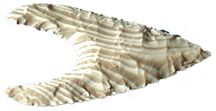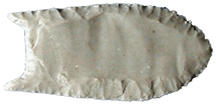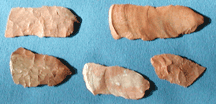Made by Woody Blackwell
Shown below is an investment grade collection of lithic
reproductions of projectile points, two knives and a sword,
all made by Woody
Blackwell , one of the world's most famous
(and infamous)
flint knappers. All of the points in this collection were
made between 1989 and 1992 when Woody lived in the
Washington, D.C. area (he served as a major in the U.S. Air
Force). Ben Ruhe put together this trove of Woody Blackwell
stone weapons and tools during this same period. Ruhe, who
also lived in Washington, D.C., visited his apartment,
talked with him on the telephone, and received mail from him
in which he discusses the various pieces. Woody is famous
for his involvement in the fraudulent
reproduction of early North American lithic projectile
points. Because his knapping skills fooled almost all of
the experts (see Peter
Bostrom's web site), Woody has earned a reputation as
one of the world's best knappers. This collection consists
of 18 projectile points, a knife, and an 18-inch
Tennessee-style "sword." All are notable for their
exceptional craftsmanship. Copies of correspondence between
Woody and Ben Ruhe (the owner of this collection), will be
made available to the purchaser. Dr. Mike Gramly, a
geologist and archaeologist (Harvard Ph.D.) who specializes
in Early Man in North America, has examined the collection
and commented favorably on the craftsmanship displayed by
Blackwell. He has no doubt whatsoever that everything viewed
was created by Blackwell. Ruhe's extensive correspondence
with Blackwell corroborates this. The largest piece is a reproduction of an 18 inch
Mississippian type of lithic sword. Blackwell used the very
difficult edge-to-edge or outré passé
percussion flaking technique to make the Mississippian
ceremonial sword. There are also two lithic knives and 17
lithic points and some channel flakes. Of the projectile
points, thirteen are fluted. Ten are of the Clovis type (one
broke as the second of two channel flakes was removed), two
are Folsoms, and one is a Cumberland. Most are made from
heat-treated Burlington Chert. The largest Clovis measures 6
inches. The large black Clovis is made out of Brandon Flint
from Brandon, Norfolk, England. This Brandon black is
considered by some knappers, including Virgil Tonn, of
Georgetown, Texas, to be the finest flint in the world. Ruhe
gave Blackwell a nodule of Brandon black and Blackwell
fashioned it into a large point. Because Blackwell's channel
flake on one side of the point veered sharply to the right
just at the tip, thus making it unsightly, Ruhe shipped it
to Tonn to retouch, which he did with great skill. In the
touchup process, however, the point became shorter by some
inch and a half. The different "hand" at work on the tip is
obvious upon cursory examination. Note that Blackwell and
Tonn earlier worked on projects together, Tonn grinding
preforms, Blackwell flaking them, then Tonn touching up the
edges. The other five points are made from a variety of
stones including dacite (matte black in color) and dramatic
black-and-white Arkansas Novaculite. Two of the other points
were made from unknown banded stone (mookite?) from
Australia. In addition to the points, there are two outstanding
knives, both notably thin. One is almost 9 inches long and
made from dramatic black and white novaculite. The other is
a large Taconic jasper (identified by Gramly) corner-tang
knife that prominently incorporates in its center a
five-rayed blastoid fossil from the Permian Age of 450
million years ago. Another highlight of the collection is
the foot and a half long chert "sword" which replicates
Indian arcana from the Mississippi River basin. The sword is
of gray novaculite. Blackwell used the extremely difficult
edge-to-edge, or outré passé, percussion
flaking technique in making this unusual weapon. One of the fluted points is broken. This occurred when
the second and last channel flake was being removed. This
breakage makes the point that the last two flaking blows
when creating a fluted point are the most dangerous from the
point of breakage, a hazard well known to Indian knappers
twelve thousand years ago. Fluted flakes from several of projectile points are
included in the collection. In one case, both channel flakes
are preserved intact. In others, the shattered channel
flakes are preserved on transparent tape. The photograph below shows the entire collection from
which you can gauge the relative sizes of the points. Below
the photograph is a table depicting all items in the
collection. Each graphic in the table is a link too a larger
photograph that shows more detail of each point. Photos of
the knife, sword and channel flakes are also included in the
table.

 |
 |
 |
 |
 |
 |
 |
 |
 |
 |
 |
 |
 |
 |
 |
 |
 |
 |
 |
 |
 |
 |
Back to: Lithic Reproductions | Collectable Artifacts | Historical Artifact Prices | Primitive Technology | contact: Ted Bailey